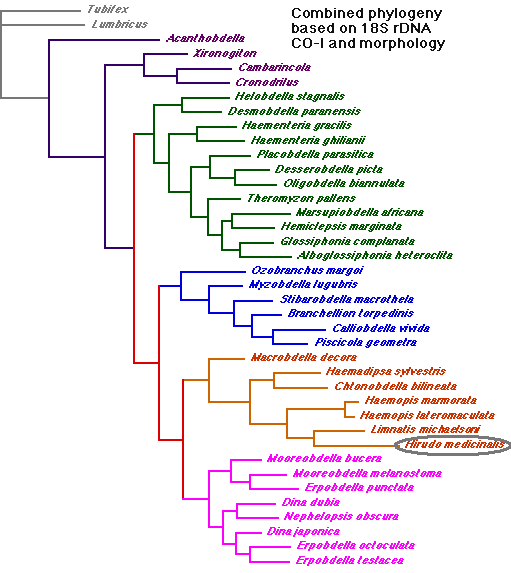Classification
There's a broad estimate of 10-100 million living species on Earth. Where does Hirudio medicinalis fit in to the grand scheme of things? Lets first take a look at the leech using the classification system that some people may recognize from their high school biology class--Linnaean Taxonomy.
| Domain:
Eukarya
Kingdom: Animalia
Phylum:
Annelidia
Order: Arhynchobdellida Family: Hirudidae Genus: Hirudo Species: Hirudo medicinalis |
| Hirudo medicinalis. Photo by Karl Ragnar Gjertsen |
The Breakdown
- Starting on top
with the broadest level of taxonomy, is the domain. Hirudio medicinalis belongs to the
domain, eukarya, meaning the cells making up the
leech have a true nucleus and membrane bound organelles. Most organisms
that people are familiar with belong to this group, including all animals,
plants, and fungi.
- The next level
of classification is the kingdom. Hirudo medicinalis
belongs to the Animal Kingdom, which is characterized by organisms that
are heterotrophic, multicellular, and lack a cell wall. Generally
speaking, most animals have some type of mobility. They also lack plant
characteristics like chloroplasts and chlorophyll.
- Hirudo medicinalis belongs to the phylum,
annelida. Annelida comes from a Latin word, anellus, which means
"little ring". If you look closely at the leech you can see
these rings that go across the length of its body. Animals that fall under
this phylum are marked by true segmentation, have three tissue layers
(triploblasitc), a true coelom, a closed circulatory system, and a
straight through digestive track. Most people are probably familiar with a
member of this phylum, the common earth worm.
- Annelids that
fall under the class, clitellata, are characterized by
possessing a unique reproductive structure called a clitellum. The
clitellum is a thickened part of the body wall secretes a cocoon-like sac
around the eggs. Organisms in this class are usually all hermaphroditic,
and lack parapodia.
- The next level
of classification is the order. H. medicinalis
belongs to Arhynchobdellida. Members of this group are characterized by
having a jaw-like structure at the anterior end of their body. More
information about about H. medicinalis specialized structures can be seen
in the adaptations section of this website.
- Leeches in
the hirudidae family are characterized by having well
developed jaws, with one row of sharp teeth. Their pharynx is short and
very muscular. They also have a crop with lobed shaped caeca.
- H. medicinalis belongs to the genus,
hirudo. Unlike other genus of leech, members of hirudo lack a
papillae(nipple-like structure) in their salivary glands. Also, the upper
lip lacks a median ventral groove. The diameter of their posterior sucker
is about 3/4 the maximum width of body.
- Finally, we get
down to the species level of taxonomy. Hirudo medicinalis
simply means medical leech- a well fitting name since it is the
species most commonly used in the medial setting. H. medicinalis is
dark green in color, with lateral lines of orange color that go down its
back.

Class relationships of leeches. Rouse and Pleijel (2001).
The tree above shows the class relationships of the annelid phylum, and is based on both morphological characteristics and molecular rDNA. As you can see, the class that Hirudo medicinalis falls under (clitellata) has a question mark by it. There is still some debate as to where the group should be placed in relation to the others.
Familial relationships of leeches. Investigators-Mark Siddall and Kathleen Apakupakul
This phylogentic tree shows the familial relationship of leeches, and the species within them. Purple represents the Branchiobdellida and Acanthobdellida, green represents Glossiphoniidae, blue represents Piscicolidae and Ozobranchidae, red represents Hirudinidae, and pink represents Erpobdellidae. This tree is based on morphological and rDNA relations.
Click here to learn about where Hirudo medicinalis lives
